The MSI B350 Tomahawk Motherboard Review: Gaming On a Budget
by Gavin Bonshor on March 12, 2018 10:45 AM EST- Posted in
- Motherboards
- AMD
- MSI
- ATX
- Zen
- AM4
- B350
- Ryzen
- Tomahawk
- Raven Ridge
System Performance
Not all motherboards are created equal. On the face of it, they should all perform the same and differ only in the functionality they provide - however, this is not the case. The obvious pointers are power consumption, but also the ability for the manufacturer to optimize USB speed, audio quality (based on audio codec), POST time and latency. This can come down to manufacturing process and prowess, so these are tested.
Power Consumption
Power consumption was tested on the system while in a single ASUS GTX 980 GPU configuration with a wall meter connected to the Thermaltake 1200W power supply. This power supply has ~75% efficiency > 50W, and 90%+ efficiency at 250W, suitable for both idle and multi-GPU loading. This method of power reading allows us to compare the power management of the UEFI and the board to supply components with power under load, and includes typical PSU losses due to efficiency. These are the real world values that consumers may expect from a typical system (minus the monitor) using this motherboard.
While this method for power measurement may not be ideal, and you feel these numbers are not representative due to the high wattage power supply being used (we use the same PSU to remain consistent over a series of reviews, and the fact that some boards on our test bed get tested with three or four high powered GPUs), the important point to take away is the relationship between the numbers. These boards are all under the same conditions, and thus the differences between them should be easy to spot.
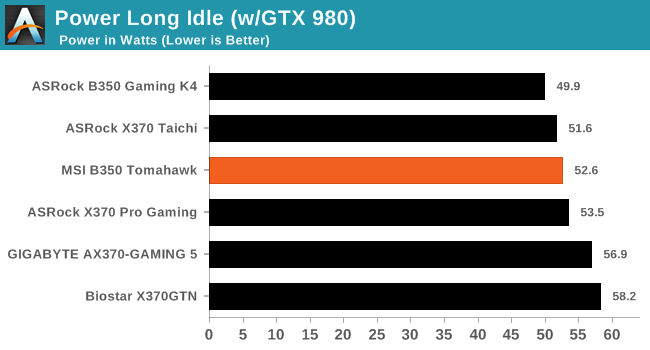

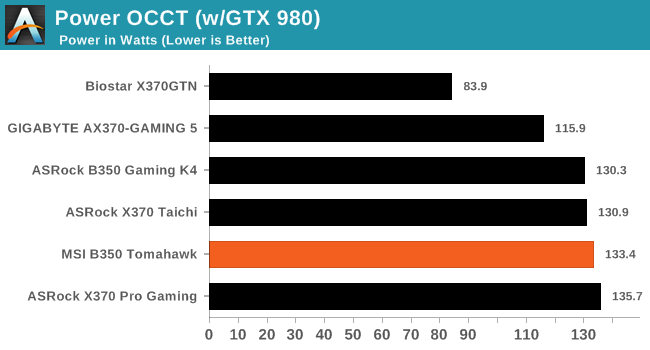
On the whole when compared to the other X370/B350 motherboards on test, the MSI B350 Tomahawk sits relatively average. At load however, there are no real advantages to being a budget B350 board.
Non-UEFI POST Time
Different motherboards have different POST sequences before an operating system is initialized. A lot of this is dependent on the board itself, and POST boot time is determined by the controllers on board (and the sequence of how those extras are organized). As part of our testing, we look at the POST Boot Time using a stopwatch. This is the time from pressing the ON button on the computer to when Windows starts loading. (We discount Windows loading as it is highly variable given Windows specific features.)
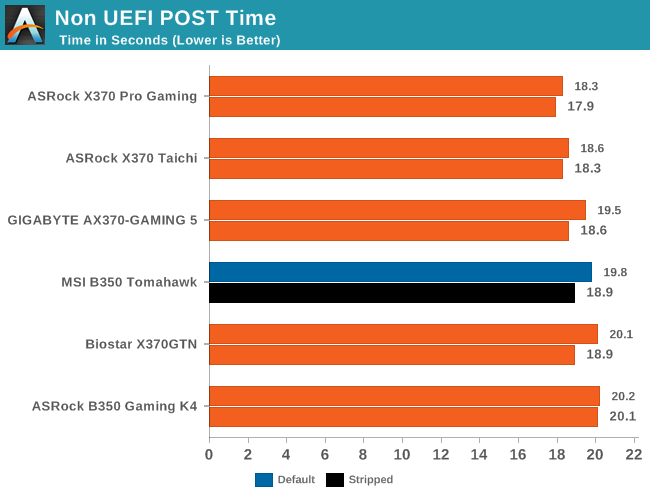
Most of the POST times on X370 seem to be in the same ball-park, differing by a second or two for the most part.
Rightmark Audio Analyzer 6.2.5
Rightmark:AA indicates how well the sound system is built and isolated from electrical interference (either internally or externally). For this test we connect the Line Out to the Line In using a short six inch 3.5mm to 3.5mm high-quality jack, turn the OS speaker volume to 100%, and run the Rightmark default test suite at 192 kHz, 24-bit. The OS is tuned to 192 kHz/24-bit input and output, and the Line-In volume is adjusted until we have the best RMAA value in the mini-pretest. We look specifically at the Dynamic Range of the audio codec used on the rear panel of the board.
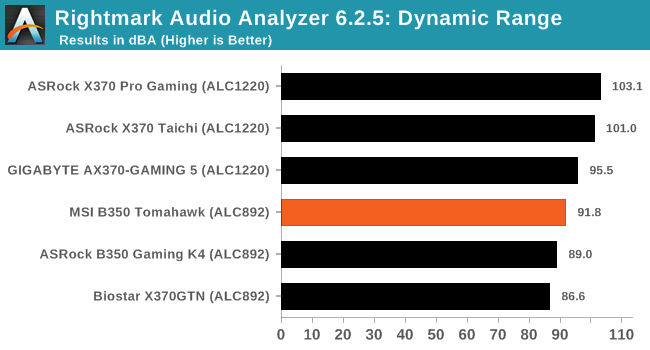
In an expected showing, the Realtek ALC892 comes reasonably close to the ALC1220 options, but can't hit the high.
DPC Latency
Deferred Procedure Call latency is a way in which Windows handles interrupt servicing. In order to wait for a processor to acknowledge the request, the system will queue all interrupt requests by priority. Critical interrupts will be handled as soon as possible, whereas lesser priority requests such as audio will be further down the line. If the audio device requires data, it will have to wait until the request is processed before the buffer is filled.
If the device drivers of higher priority components in a system are poorly implemented, this can cause delays in request scheduling and process time. This can lead to an empty audio buffer and characteristic audible pauses, pops and clicks. The DPC latency checker measures how much time is taken processing DPCs from driver invocation. The lower the value will result in better audio transfer at smaller buffer sizes. Results are measured in microseconds.
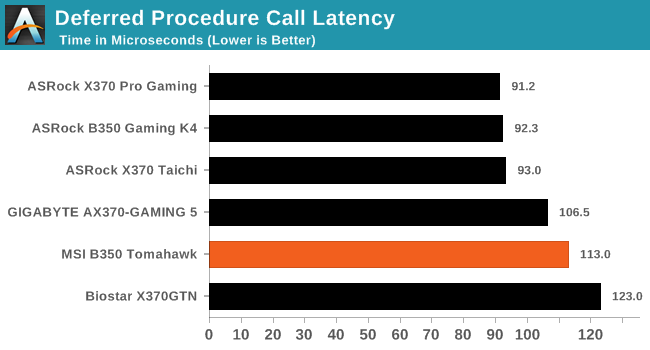
None of the boards tested thus far have been optimised for DPC latency, although all of the test boards managed to squeeze under 150 microseconds with relative ease. The B350 Tomahawk does fall behind from the ASRock boards in our testing by around 21 microseconds; not a massive difference in real world scenarios however.










46 Comments
View All Comments
drexnx - Monday, March 12, 2018 - link
the RGB-LED header on the regular tomahawk is a reduced functionality version that only gives you those 7 color choices - not 16.7 million like it shouldSaabensippen - Monday, March 12, 2018 - link
In the "board explorer" in the BIOS on my tomahawk it clearly identifies two of the rear usb ports as USB 3.1 Gen2. I have never tested the speeds so I do not know if they actually run at that. Also, I have read TERRIBLE things about the latest BIOS such as RAM refusing to run below 1.5v, vcore not going below 1.3, and fan curves not being adjustable anymore. I have not updated, still on 1.9 or whatever the one from a few months ago was.Geranium - Tuesday, March 13, 2018 - link
The board explorer showing wrong information. Couldn't find mention of USB 3.1 AKA USB 3.1 G2 on specification page.https://www.msi.com/Motherboard/B350-TOMAHAWK/Spec...
Saabensippen - Tuesday, March 13, 2018 - link
Yeah, I don't really know. The tomahawk arctic which is the same but white says that it has g2 so who knows. My BIOS says it's g2... It wouldn't be the first time that something reports that it's something other than what it is.vkristof - Friday, March 16, 2018 - link
This could be a function of the B350 FCH supporting USB 3.1 Gen2 per AMD's claims, but the higher speed not actually working reliably in the real world. That might be the reason that MB manufacturers have to add the Asmedia USB 3.1 Gen2 chip for their motherboards that actually claim Gen 2 ports.I'm somewhat surprised that I haven't seen any articles that detail this AMD Gen 2 wrinkle. Maybe that AMD reddit guy might respond...
Saabensippen - Thursday, March 22, 2018 - link
I would be interested to find out. I don't run external hard drives or anything that would benefit from it though.Saabensippen - Thursday, March 22, 2018 - link
Update: The latest BIOS 7A34v1F does not have any of these problems, although I had never personally experienced them with the earlier BIOS, only read about them. For me this board has lasted a year without any issues, running a 1700 at 3.75 at 1.264v. I have read about issues with it on forums and newegg (A lot of DOAs it seems) but never experienced any. I must be lucky. Also, the board explorer still says there are two USB 3.1 Gen2 ports on the back. At least one USB port from the header IDs as USB 3.1 Gen2 as well.barleyguy - Monday, March 12, 2018 - link
I bought a B350 Tomahawk at launch and mine was terrible. I had two problems. The first was corruption on an m2 ssd. The second was that it wouldn't work properly with any sound card other than the the onboard. I tried usb and pcie sound cards, all very high end, and they had glitches. Tjis was true under both Windows 10 and Windows 7.In summary, might be an ok board, but the one I owned wasn't. I replaced mine with an Asus B350 Prime Plus, which resolved all issues.
Myrandex - Monday, March 12, 2018 - link
FYI I bought mine at launch and have enjoyed it, but things did get better with bios updates too, especially with memory speed capabilities.Honed1967 - Tuesday, March 13, 2018 - link
All the way you right